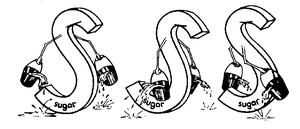
Polyuria: Glucose cannot leave the body by itself--it must take water with it. Losing too much water means the body tries replacing it and this causes thirst, or polydipsia. When too much water is lost through excess urination and the excess drinking cannot make up for it, dehydration can occur.
Dehydration is a generally dangerous condition for any animal, in which the tissues are low on water. It is particularly likely in poorly-regulated or hyperglycemic diabetics, and also particularly dangerous for them, because it can quickly trigger diabetic ketoacidosis.
Excessive thirst (medical term polydipsia [pah-lee-DIP-see-uh]; abreviated as PD) is a symptom of diabetes. Diabetic animals often drink incessantly because they are dehydrated from the cell-dehydrating effects of hyperglycemia, plus the effects of their bodies casting off the excess glucose through urination, taking hydration with it.
Chronic mild dehydration (common in diabetic cats) can lead to bowel motility problems among other things. One thing to check in the case of constipation is hydration level.
|
To check if your pet is dehydrated, look at their gums and their skin. Skin will not snap back quickly when pinched, gums will be tacky or dry; more signs can be found at the link below[1]. This condition can be deadly or lead to deadly complications, within a day, so it must be remedied immediately. In any case of dehydration, check frequently for ketones. Mild dehydration may be possible to remedy with lots of water; if this isn't working, the next step is subcutaneous fluid injections, usually performed by your vet. (Though some people see this problem enough to have the equipment and fluids at home.) | ||
Untreated dehydration can cause the blood to be more hypertonic, which in turn can suck water from the cells causing more dehydration[2]. It's a vicious circle.
When using insulin, dehydration can cause hypoglycemia[3]